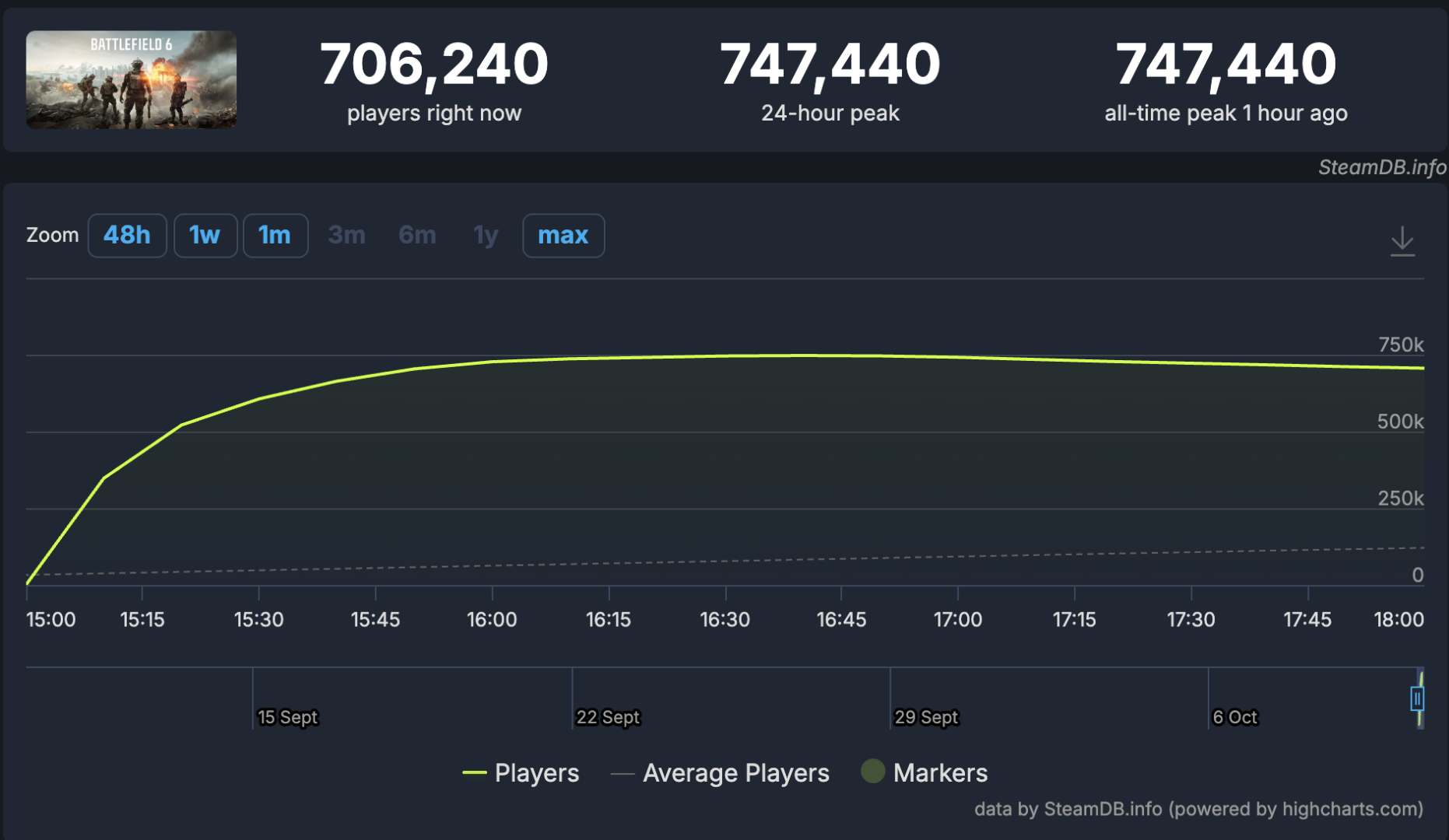Battlefield 6’s launch has become one of the biggest events in recent PC gaming history. Within its first hour on Steam, the game reached over 700,000 concurrent players, making it the most successful EA launch ever on the platform. The milestone wasn’t just impressive — it was historic, marking Battlefield’s long-awaited comeback.
This surge shows more than just hype. It signals renewed trust in the Battlefield franchise, powerful marketing momentum, and a strong base of loyal fans who were ready the moment servers went live. In less than 60 minutes, Battlefield 6 went from launch to a full-scale global phenomenon.
The record instantly placed Battlefield 6 among Steam’s top games of all time in terms of player count, surpassing long-standing giants like Apex Legends and Counter-Strike 2. It also set a new benchmark for what EA can achieve with a coordinated worldwide release.
Beyond the numbers, this explosive debut reflects a deeper message: Battlefield is back, stronger and more relevant than ever. After years of uneven performance, this title proves that large-scale shooters can still capture the attention of millions.
Steam Launch Surge & Server Pressure
The first hour after launch saw a record-breaking spike in concurrent users — roughly 747,000 players connected through Steam alone. That figure makes Battlefield 6 not just the biggest Battlefield release, but also the largest EA title ever on the platform.
However, the massive demand didn’t come without challenges. Servers were under heavy pressure almost immediately. Many players experienced long queues, delayed matchmaking, or partial connection drops. Some reported being unable to join games at all during the initial surge.
The main bottleneck came from the EA App, where thousands of users couldn’t even start the game because of launcher errors. Some systems falsely asked players to buy add-ons or DLC that didn’t exist, locking them out of their purchased copies. EA quickly acknowledged the issue, apologized, and began rolling out compensation for affected users in the form of XP boosts and early battle pass access.
Fortunately, the situation improved over time. Within several hours, autoscaling systems stabilized most servers, queue times shortened, and connection reliability increased. What started as a chaotic stress test has now become a symbol of Battlefield 6’s popularity — proof that demand can overwhelm even modern server architecture when a franchise hits the right note.
Comparison with Previous Battlefield Titles
Battlefield 6’s success stands out even more when compared to earlier games in the series.
- Battlefield V peaked at around 116,000 concurrent players on Steam.
- Battlefield 2042 reached a slightly lower high of about 107,000.
- Battlefield 6, by contrast, exploded to nearly 750,000 concurrent users within its first day.

This difference is monumental. Battlefield 6 didn’t just beat past entries — it multiplied their peaks by six or seven times. It also surpassed the total active user base of many other top shooters during the same period, showing how strong the Battlefield brand remains when executed properly.
The comparison highlights how far the series has come since Battlefield 2042’s difficult launch. That game’s technical issues and mixed reviews hurt community trust. Battlefield 6, however, has reversed the narrative completely. Players have praised its polished mechanics, new engine performance, and large-scale map design, all contributing to renewed enthusiasm.
From a broader industry perspective, this kind of growth demonstrates that traditional large-scale shooters still have massive potential. When paired with the right marketing and community engagement, even a long-running franchise can break records that once seemed unreachable.
Server Strain, Queues & Launch Stability
Massive launch days come with inevitable friction, and Battlefield 6 was no exception. As concurrent users climbed into the hundreds of thousands, matchmaking servers began to buckle under the strain. Players in multiple regions faced waiting times between five and fifteen minutes before being able to load into matches.
Some reported failed sessions or mid-match disconnects, especially during the first few hours after release. The EA App also suffered an outage that prevented many PC users from accessing the game altogether. The company quickly addressed these technical issues, urging players to use Steam directly while fixes were being implemented.
To EA’s credit, the studio responded quickly and transparently. Engineers expanded server capacity in real time, activating backup clusters and rebalancing network traffic. Within the first day, queue times dropped dramatically, and most regions reported stable matchmaking. While launch-day chaos is common for blockbuster titles, Battlefield 6 managed to recover faster than most.
The episode now serves as a live stress test for EA’s new infrastructure — and the results are promising. Stability improved rapidly, and player counts remained high even after the first 24 hours. That shows strong retention and a healthy foundation for long-term live service growth.
Why This Record Matters
- A powerful first impression
High concurrent numbers shape early perception. Seeing hundreds of thousands of players online immediately sends a clear signal to the gaming community: Battlefield 6 is relevant again. Early positivity drives more purchases, more streaming coverage, and sustained player retention in the critical launch window. - Massive monetization potential
More players online means greater exposure to in-game economies — battle passes, skins, weapon cosmetics, and seasonal rewards. With a player base of this size, even modest spending translates into huge revenue streams for EA and its partners. - Technical reputation and trust
Battlefield 6’s ability to handle — and recover from — record traffic strengthens EA’s technical credibility. Maintaining uptime during one of the busiest launches in Steam history shows improved backend resilience. That trust will be crucial for future updates and live seasons. - Redemption for the franchise
After Battlefield 2042’s rough reception, fans were skeptical. Battlefield 6’s success is a redemption story. It proves that EA and DICE listened to community feedback and invested heavily in stability, gameplay, and content design. The community response has been overwhelmingly positive, creating the best buzz the franchise has seen in years. - Opportunity for third-party services
When millions of players rush into a new multiplayer game, competition gets fierce. Latecomers or casual players often look for ways to catch up quickly. This surge creates strong demand for carry and boosting services that help users unlock weapons, level faster, and stay competitive — an area where CarryLord can lead the way.
CarryLord’s Role — Riding the Battlefield 6 Wave
With Battlefield 6’s explosive start, CarryLord is scaling its operations to meet player demand. The company is preparing specialized Battlefield 6 packages tailored for different types of players and goals.
Helping new players catch up
Many users couldn’t access the game immediately due to server queues or launcher bugs. Now they find themselves several levels behind. CarryLord offers targeted progression services designed to help players quickly unlock weapons, attachments, and essential items so they can rejoin the competition at full strength.
Accelerated weapon and class progression
Battlefield 6 features deep progression systems across classes and loadouts. Players who want to unlock specific gear quickly can use CarryLord’s structured carry packages to bypass long grind sessions and get straight to advanced content.
Coaching and tactical guidance
Beyond boosting, CarryLord also supports players who want to improve their performance legitimately. Coaching sessions focus on map knowledge, squad coordination, and meta loadouts — essential for those who want to excel in ranked or large-scale modes.
Scalable support for ongoing demand
As Battlefield 6’s live service evolves, new content, events, and seasonal drops will keep players coming back. CarryLord’s infrastructure is built to adapt — offering limited-time bundles, event-specific carries, and competitive progression boosts throughout each update cycle.
By aligning with Battlefield 6’s growth curve, CarryLord not only meets immediate demand but also establishes long-term partnerships with players seeking consistent, reliable support.
Additional Context & Future Outlook
Early estimates suggest Battlefield 6 has already surpassed 6.5 million copies sold across all platforms during its first week. On Steam, it continues to hold one of the highest concurrent player counts in the world. The game’s beta had already shown massive engagement, with over half a million players online simultaneously — a clear sign of anticipation.
Battlefield 6 also introduced new technology under the hood. EA’s Javelin anti-cheat system now operates at the kernel level, offering stronger protection against hacks and exploits. Although it initially caused conflicts with some other anti-cheat programs, its effectiveness has been praised for maintaining fair play during the busiest launch hours.
The biggest challenge going forward will be stability and player satisfaction. EA’s rapid recovery from launch issues has been encouraging, but consistency over time will determine whether Battlefield 6 maintains its top-tier position. Continuous updates, community engagement, and responsive balancing will be key to keeping momentum alive.
If the developers maintain this trajectory, Battlefield 6 could become one of the most successful live-service shooters of the decade — a title capable of sustaining millions of active users for years to come.











